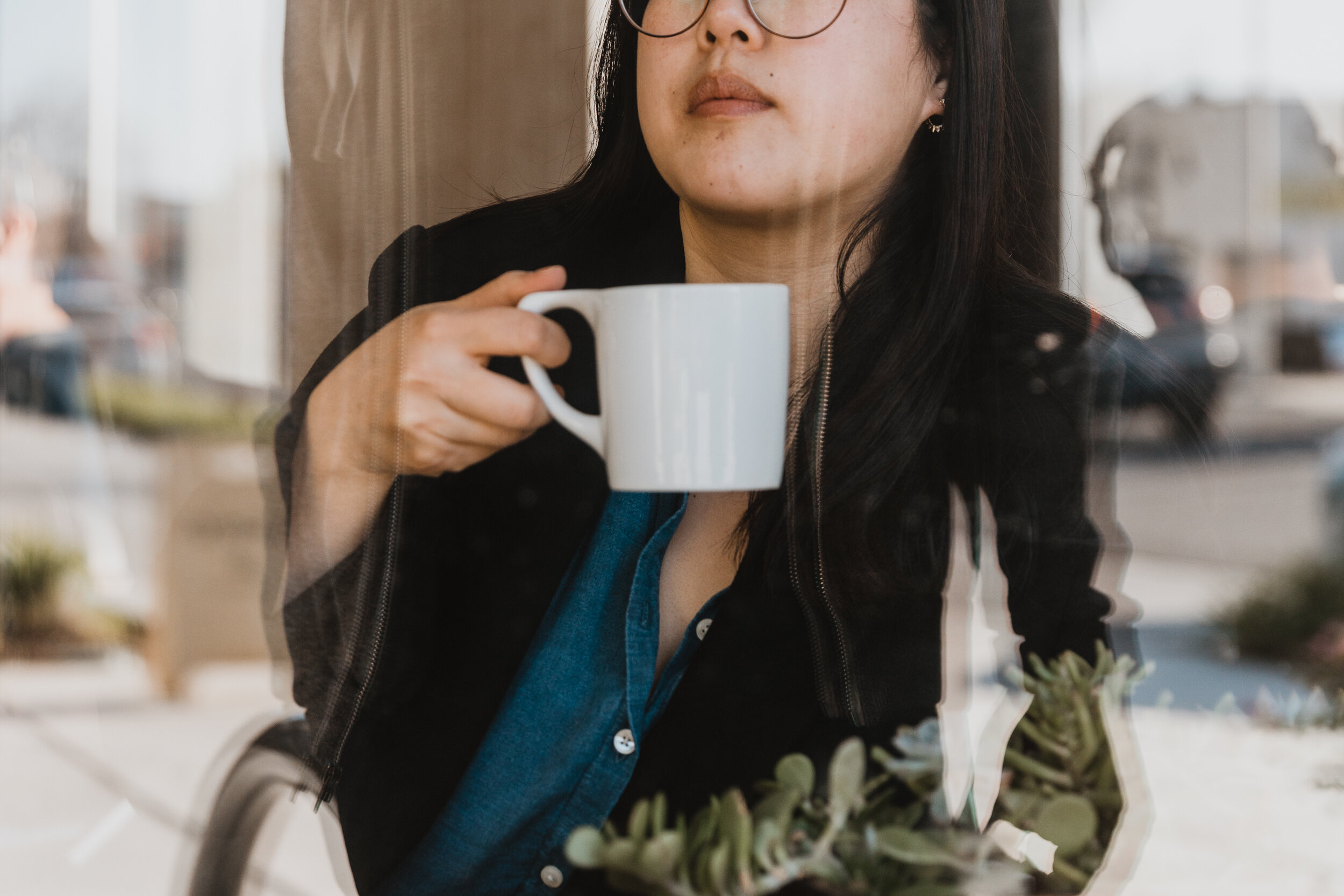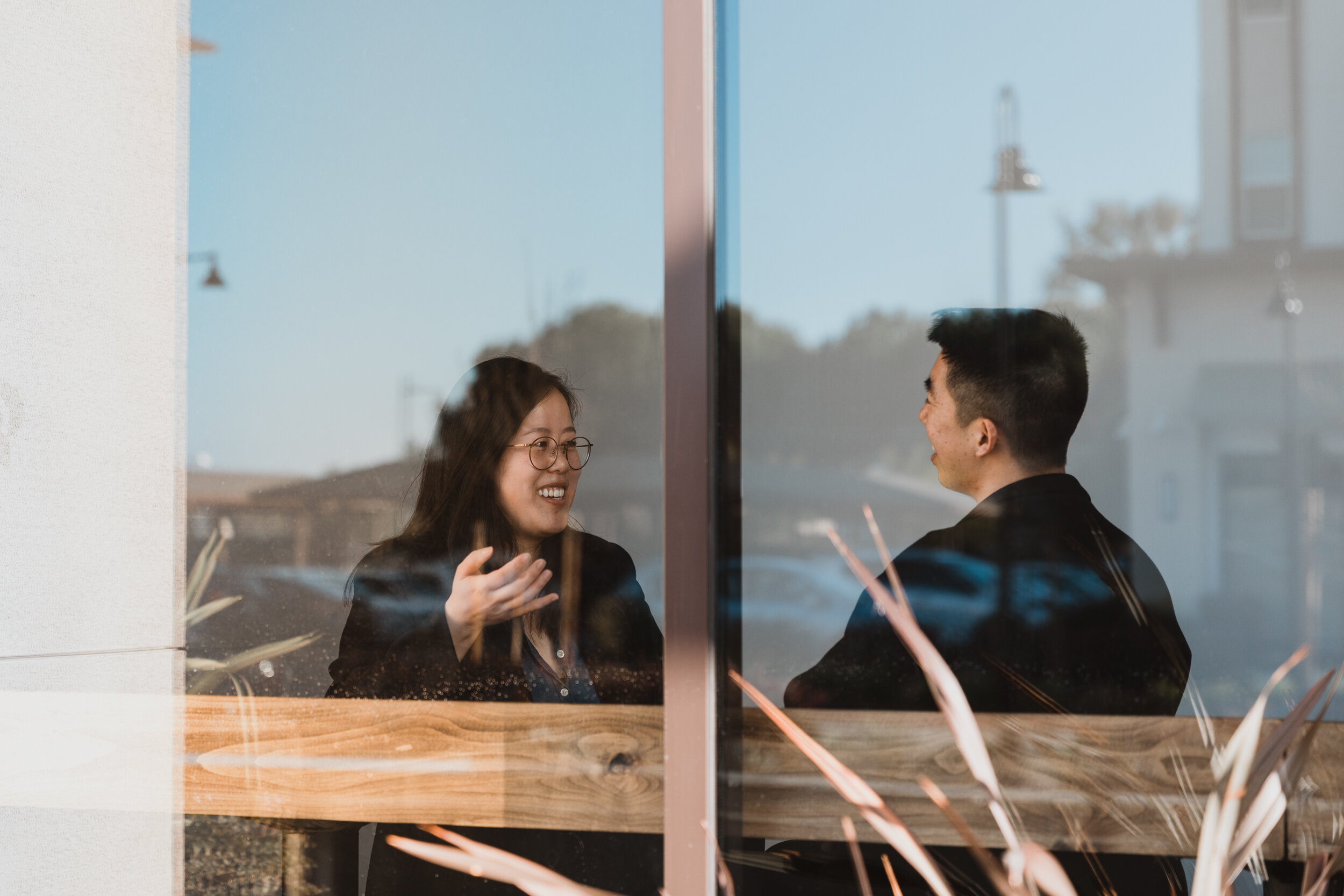IT’S NOT ALL BLACK AND WHITE
uncovering the intersectionality of an asian american woman’s identity
ERICA LI
chinese american
Erica has lived her life thinking there was only one way for an Asian American, or in her case, an Asian American woman, to behave. Asian women are often expected to be quiet, obedient and submissive. This detrimental narrative negatively impacts the overall community and ecosystem. Since becoming an adult, Erica took the opportunity to question the role her race and gender plays in American culture and reassess her personal identity. She learned to unapologetically own being an Asian American woman, and all the weight it carries.
Now, she advocates for diversity, equity and inclusion efforts at her workplace, all while fostering important conversation of how the intersectionality between being Asian and a woman is not always black and white.
Q: What do you feel is the biggest misconception about your cultural identity?
A: There's still a lot of taboo and social stigma surrounding Asian women. I think there are qualities of being Asian and qualities of being a woman that can exacerbate with each other. When I think about how the world actually sees me, regardless of the situation, whether it’s work, dating or friendships, you can be seen in a different way than what you originally expected.
If they don’t fit the norm of what an Asian woman is supposed to be, then people are quick to make comments like, “They’re louder than I expected” or “They’re bossy.” Women are already stereotyped and assumed to be nicer, so when you’re an Asian woman, the expectations are heightened even more.
Q: Tell us about your upbringing – where you grew up and the people you surrounded yourself with.
A: I grew up in the Bay Area, went up north near Sacramento for college, and then came back home after graduation. I was surrounded by predominantly Asian people, and going to college where there were more white people than I was used to made me realize how much of an Asian bubble I grew up in.
Home was a Chinese immigrant household with a fairly balanced presence of both Chinese and American values. I was instilled American values of doing whatever I wanted with my life and career, but still felt the pressures of Chinese values to be perfect and ideal. Although the execution of the two value systems were different, I think the heart of the messages were the same. Both cultures just want their children to do well, to succeed, and be happy.
Q: Aside from leaving the comfort of an Asian-centric environment, what else prompted you to question your identity as an Asian American?
A: I started thinking about perceptions of Asian Americans when the movement for Asian representation in media started gaining momentum. It made me disentangle an interesting dynamic of how you can feel like an American, but definitions of what “American” means could vary from culture to culture. Especially once you are surrounded by people who don’t identify with you, you run into this subconscious “expectation” of how to be American that you didn’t notice before.
You can travel anywhere in the U.S. and realize it's not like the Bay Area. It made me realize how much of a privilege it is to be part of the Asian community because everywhere you go, there is going to be the Asian diaspora that you can find. But the same time, it’s troubling when you look at the specific schemas put in place for Asian people - like the model minority myth and how much you are convinced that “you are part of what America values,” but not all the way – like with the bamboo ceiling. It’s frustrating how much we're made to feel like we're part of America, but only in ways someone else has allowed.
“It’s frustrating how much we're made to feel like we're part of America, but only in ways someone else has allowed.”
Q: Before we get into understanding Asian stereotypes specifically, do you have any examples of how the Asian community has hit the bamboo ceiling?
Editor’s Note: The term "bamboo ceiling" was coined in 2005 by Jane Hyun in ‘Breaking the Bamboo Ceiling: Career Strategies for Asians,’ where she addresses the barriers faced by many Asian Americans in the professional arena, such as stereotypes and racism. It’s a combination of individual, cultural, and organizational factors that impede Asian Americans' career progress inside organizations.
A: I have a parallel to the workplace experience of bamboo ceilings in how Asian communities can be treated in their neighborhoods. There's a book called Trespassers?: Asian Americans and the Battle for Suburbia, which talks about how a Bay Area city’s government wasn’t supporting Asian plazas to foster the same way as other cities with predominantly Asian residents.
The book shares that although the city had a large Asian demographic, policies were put in place to make it easier to evict Asian plaza business owners or deny building construction in the first place. Even though the store and restaurant offerings addressed residents’ needs, it breached the historical norms of what the city was used to and expected of the Asian community.
Q: You also brought up the model minority myth. Tell us more about your understanding of it and how it has affected your opinion of how others see the Asian community.
A: It’s funny because when I was younger, I actually thought the model minority myth was a good stereotype because why wouldn't we want to assume these good traits? But when I started thinking about what the myth does to the community, I began to question the validity of what I thought was positive. Questioning the validity teaches you how to pull apart the hidden agendas.
Take Asian representation in the media. It's very easy and fun to see your culture represented on screen, but the challenge is taking that extra step to question why this wasn’t a normal occurrence in the first place. You begin to realize that there are beliefs that you have held on to be normal and true that were actually convinced of you for someone else’s gain.
Q: Can you tell us about some of the traditional values or “normal” situations that you’ve had to reassess later in your life?
A: One value that I had to question was work ethic expectations between Eastern and Western cultures. Compared to Western culture, where having a passion and a “purpose in life” is the ultimate motivator, I went into the workforce having a very Eastern mindset of, “you have to work hard no matter what,” which basically is this unrealistic idea that if you work hard and keep your head down, people will recognize your worth.
I find that this Eastern value isn’t really applicable to modern workplaces. But what’s interesting is that there is a Western advantage for Asian Americans to hold onto this traditional value. Western society can benefit from people-of-color keeping their heads down. It can distract you from opportunities to move up and create more diversity in leadership.
“I find that this Eastern value isn’t really applicable to modern workplaces. But what’s interesting is that there is a Western advantage for Asian Americans to hold onto this traditional value. Western society can benefit from people-of-color keeping their heads down. It can distract you from opportunities to move up and create more diversity in leadership.”
Q: Can you explain how Asian women have this heightened expectation in society to fall in line with the traditional “woman” stereotype?
A: I remember getting feedback at work where someone said, “Oh, you should speak up more.” But then I thought, “Do I really? Or is it that when I do speak up, you just don't listen – because you don’t expect me to.”
Sometimes people’s comments about Asian women, whether they've been on dates with them, worked with them, or are friends with them, often are rooted in this thinking of, “she's not doing what I thought an Asian woman would do.” It definitely shows how many additional layers of being a minority, in both gender and race, there can be.
Q: As you recognize the perceptions of how others see Asian women, how do you aim to help in the workplace?
A: I’m definitely passionate about wanting to contribute to building a sense of community and value for the work being done. You can say in a workplace that we want people to help each other, but if you don't reward that work or build in the time for people to do it, then the bonds never take place. I aim to do what I can to create spaces at work for inclusivity and recognition systems to show its value.
Q: Do you have an example of how one can help support the entire community?
A: I had an opportunity to volunteer at a summit for Asian women leaders. The community was small, but surprisingly, many of them still hadn't met each other. They shared workplace stories they experienced - everything from the guilt of going on maternity leave to microaggressions.
Despite the negative stories, there were also positive ones. The feedback from the summit was that getting to share and resonate with others was the highlight of coming together. Oftentimes, the best way to support a community is just to make people aware that they’re part of one.
Q: Foster a sense of a community to continue the conversation. Well said. What can one do personally?
A: Sounds cliche, but I think it’s just to be yourself! Do whatever makes you happy and whatever helps you love yourself. You’ll naturally encourage a culture of diverse perspectives.
I like to think I live being unapologetically myself, and I hope it encourages others to be unapologetically themselves as well. We’re all already part of this ecosystem, so if people commit to being authentic, I believe that it will encourage diversity in behavior, thought and personality.
Q: How can people start having these important conversations if they are not used to questioning societal norms and traditional ways of thinking?
A: It’s important to surround yourself with a strong personal community to be able to talk about these things with. This is your network of people who are going to be sharing their own learnings. If you think about how easily we share memes and funny videos, imagine what would happen if we shared amazing stories and perspectives about our identities.
“If you think about how easily we share memes and funny videos, imagine what would happen if we shared amazing stories and perspectives about our identities.”
Q: What do you want our readers to take away from your story?
A: Not everything is black and white. No one is inherently bad, and no one is inherently better. It’s okay to reassess the values you once believed in before you were able to comprehend this bigger world that we live in. Everyone comes with their own experiences and biases and we need to actively learn from each other and develop this understanding, especially when it comes to identity.
“Everyone comes with their own experiences and biases and we need to actively learn from each other and develop this understanding, especially when it comes to identity.”
CONNECT WITH ERICA
MORE THAN ASIAN CREATIVE TEAM
MTA Creative Direction: Alex Hallmark
MTA Art Direction: Lawrence Ricardo
Shoot Concept: Angelina Hong and Kelly Luu
Photography: Kelly Luu
Story Editor: Jay Mehta









